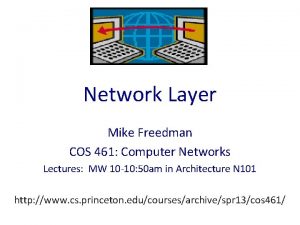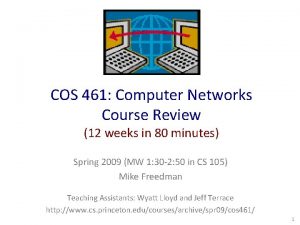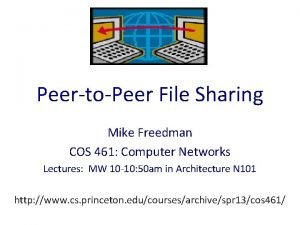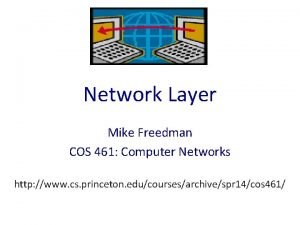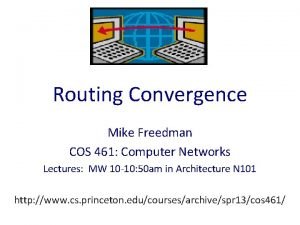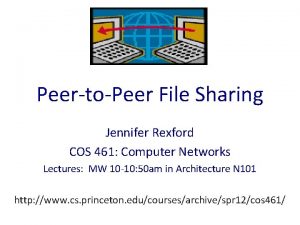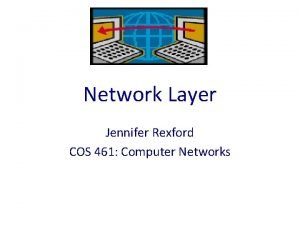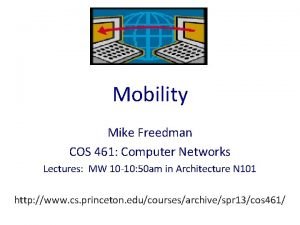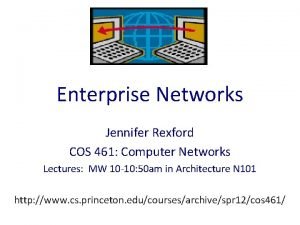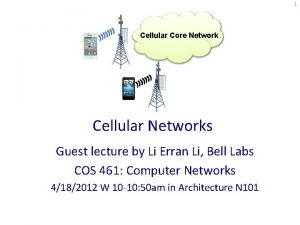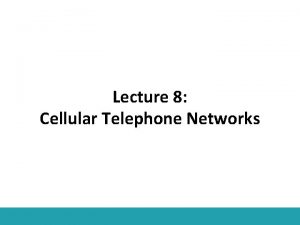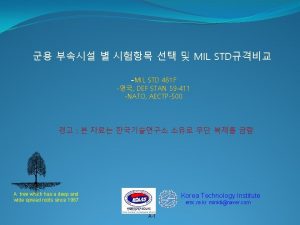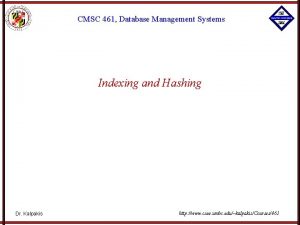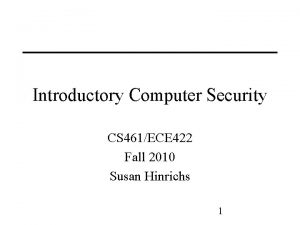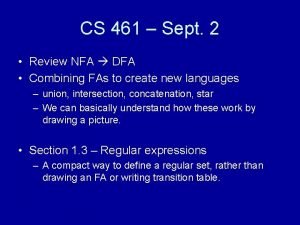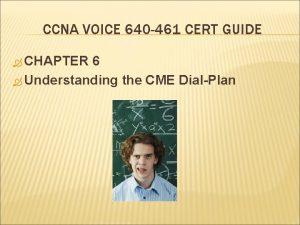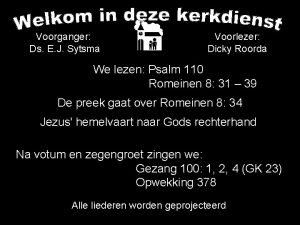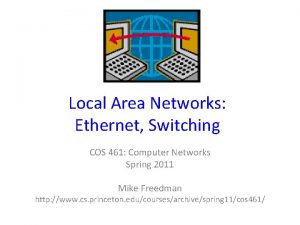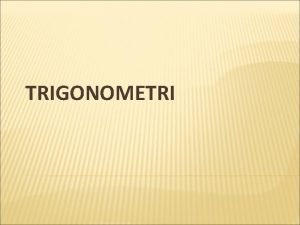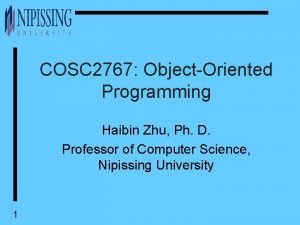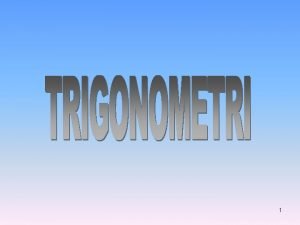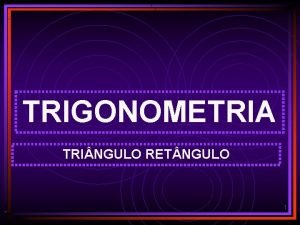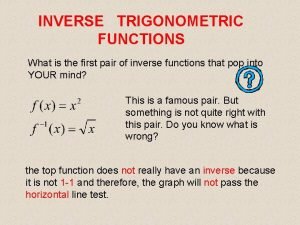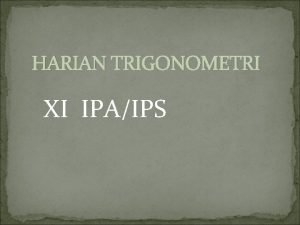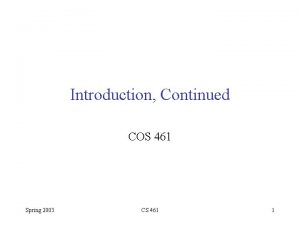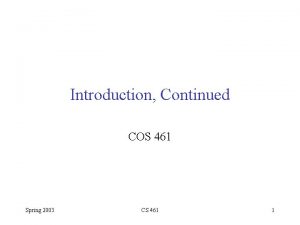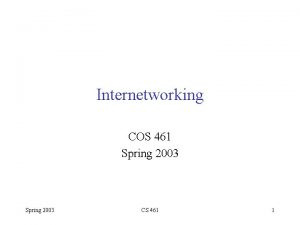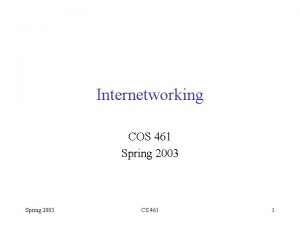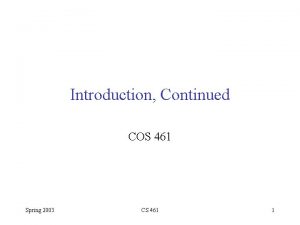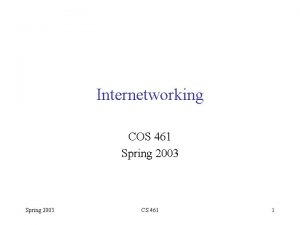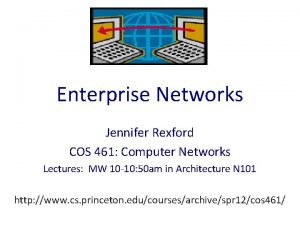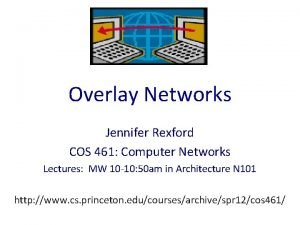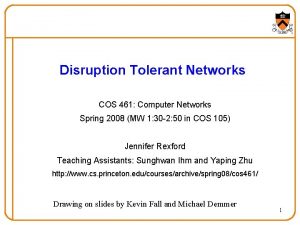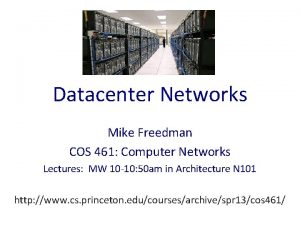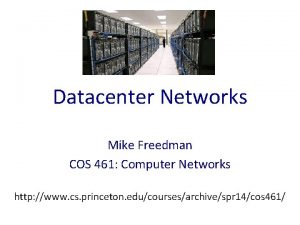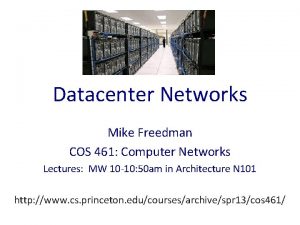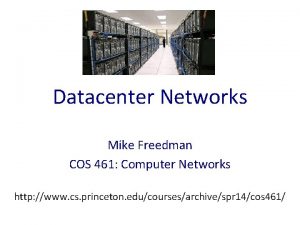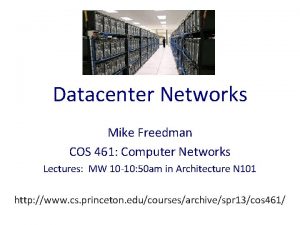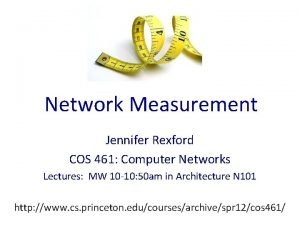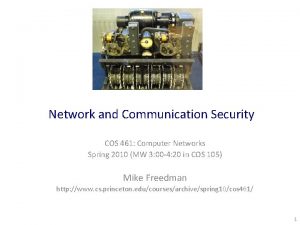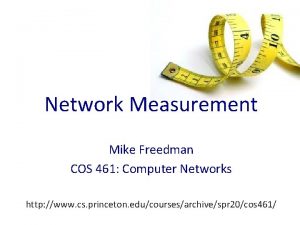1 Cellular Core Network Cellular Networks COS 461







































- Slides: 39

1 Cellular Core Network Cellular Networks COS 461: Computer Networks Spring 2013 Guest Lecture by Li Erran Li, Bell Labs 4/10/2013 W 10 -10: 50 am http: //www. cs. princeton. edu/courses/archive/spring 13/cos 461/

Mobile Data Tsunami Challenges Current Cellular Technologies • Global growth 18 times from 2011 to 2016 • AT&T network: – Over the past five years, wireless data traffic has grown 20, 000% – At least doubling every year since 2007 • Existing cellular technologies are inadequate – Fundamental redesign of cellular networks is needed Source: CISCO Visual Networking Index (VNI) Global Mobil Data Traffic Forecast 2011 to 2016 2

3 Outline Goal of this lecture: understand the basics of current cellular networks • Physical Layer • Access Procedure – Why no carrier sensing • • • Connection Setup Mobility Management Power Management and Mobile Apps Differences between 3 G and LTE What is Next Conclusion

4 Physical Layer: UMTS Code Division Multiple Access (CDMA) • Use of orthogonal codes to separate different transmissions • Each symbol or bit is transmitted as a larger number of bits using the user specific code – Spreading • Spread spectrum technology – The bandwidth occupied by the signal is much larger than the information transmission rate – Example: 9. 6 Kbps voice is transmitted over 1. 25 MHz of bandwidth, a bandwidth expansion of ~100

Physical Layer: LTE • The key improvement in LTE radio is the use of OFDM • Orthogonal Frequency Division Multiplexing – 2 D frame: frequency and time – Narrowband channels: equal fading in a channel • Allows simpler signal processing implementations – Sub-carriers remain orthogonal under multipath One resource block propagation One resource element y nc e qu fre 12 subcarriers during one slot (180 k. Hz × 0. 5 ms) 12 subcarriers Time domain structure Frame (10 ms) One OFDM symbol One slot time Slot (0. 5 ms) Subframe (1 ms)

6 Physical Layer: LTE (Cont’d) 1 T T large compared to channel delay spread Orthogonal Frequency Division Multiple Access (OFDM) §Closely spaced sub-carriers without guard band § Each sub-carrier undergoes (narrow band) flat fading - Simplified receiver processing Frequency Narrow Band (~10 Khz) Wide Band (~ Mhz) § Frequency or multi-user diversity through coding or scheduling across sub-carriers § Dynamic power allocation across sub- carriers allows for interference mitigation Sub-carriers remain orthogonal under across cells multipath propagation § Orthogonal multiple access

7 Physical Layer: LTE (Reverse link OFDM) User 1 § Users are carrier synchronized to base station § Differential delay between users’ signals at the base need to be small compared to symbol duration User 2 W § Efficient use of spectrum by multiple users § Sub-carriers transmitted by different users are orthogonal at the receiver - No intra-cell interference User 3 § CDMA uplink is non-orthogonal since synchronization requirement is ~ 1/W and so difficult to achieve

LTE Scheduling: Downlink • Assign each Resource Block to one of the terminals – LTE – channel-dependent scheduling in time and frequency domain – HSPA – scheduling in time-domain only Time-frequency fading, user #2 Time-frequency fading, user #1 User #1 scheduled User #2 scheduled 1 m s Tim e ncy Freque z 180 k. H

9 LTE Scheduling: Uplink Frequency Each color represents a user Each user is assigned a frequency-time tile which consists of pilot sub-carriers and data sub-carriers Block hopping of each user’s tile for frequency diversity Time Typical pilot ratio: 4. 8 % (1/21) for LTE for 1 Tx antenna and 9. 5% for 2 Tx antennas Pilot sub-carriers

10 Physical Layer LTE vs Wi. Fi • Speed: LTE is designed to operate with a maximum mobile speed of 350 km – Shorter channel coherence time, more frequent pilot transmissions • Coverage: several kilometers – Larger delay spread, more guard time overhead

11 Access Procedure • Cell Search Base station – Base station broadcasts synchronization signals and cell system information (similar to Wi. Fi) – UE obtains physical layer information • UE acquires frequency and synchronizes to a cell • Determine the start of the downlink frame • Determine the cell identity • Random access to establish a radio link UE 1 UE 2

12 Random Access UE Base station Core network Step 1: random access request (pick one of 64 preambles) Step 2: random access response Adjust uplink timing Step 3: transmission of mobile ID Only if UE is not known in Base station Step 4: contention resolution msg If ID in msg matches UE ID, succeed. If collision, ID will not match!

13 Random Access (Cont’d) Why not carrier sensing like Wi. Fi? • Base station coverage is much larger than Wi. Fi AP Base station – UEs most likely cannot hear each other • How come base station can hear UEs’ transmissions? – Base station receivers are much more sensitive and expensive UE 1 UE 2

14 LTE Architecture • • • e. Node. B 1 Cellular Core Network MME/HSS e. Node. B 2 e. Node. B 3 P-GW S-GW 2 UE 2 GTP Tunnels • • S-GW 1 UE 1 • UE: user equipment e. Node. B: base station S-GW: serving gateway P-GW: packet data network gateway MME: mobility management entity HSS: home subscriber server Internet and Other IP Networks

15 Connection Setup • Session Requests – UE to base station – Base station to MME • MME obtains subscriber info from HSS, selects SGW and P-GW – S-GW sends to P-GW • P-GW obtains policy from PCRF MME Session Request UE S-GW P-GW

16 Connection Setup (Cont’d) • Session Response – Establishes GPRS Tunnels (GTP) between S-GW and P-GW, between S-GW and UE – Base station allocates radio resources to UE MME UE S-GW P-GW Session Response

17 Mobility Management Handoff • Handoff without change of S-GW MME – No change at P-GW • Handoff with change of S-GW or MME • Inter-technology handoff (LTE to 3 G) UE S-GW P-GW

18 Mobility Management (Cont’d) Paging • If S-GW receives a packet to a UE in IDLE state, inform MME • MME pages UE through base station Paging Request UE RRC_IDLE MME S-GW Packet received P-GW

19 Power Management: LTE • UE runs radio resource control (RRC) state machine • Two states: IDLE, CONNECTED • Discontinuous reception (DRX): monitor one subframe per DRX cylce; receiver sleeps in other subframes Courtesy: Morley Mao

20 Power Management: UMTS • State promotions have promotion delay • State demotions incur tail times Tail Time Delay: 1. 5 s Delay: 2 s IDLE Tail Time Courtesy: Feng Qian Channel Radio Power Not allocated Almost zero CELL_FACH Shared, Low Speed Low CELL_DCH High Dedicated, High Speed

Example in Detail: RRC State Machine for a Large Commercial 3 G Network 21 DCH Tail: 5 sec Promo Delay: 2 Sec FACH Tail: 12 sec Tail Time Waiting inactivity timers to expire DCH: High Power State (high throughput and power consumption) FACH: Low Power State (low throughput and power consumption) IDLE: No radio resource allocated Courtesy: Feng Qian

Example in Detail: Pandora Music Problem: High resource overhead of periodic audience measurements (every 1 min) Recommendation: Delay transfers and batch them with delay-sensitive transfers Courtesy: Feng Qian 22

Why Power Consumptions of RRC States so different? • IDLE: procedures based on reception rather than transmission – Reception of System Information messages – Cell selection registration (requires RRC connection establishment) – Reception of paging messages with a DRX cycle (may trigger RRC connection establishment) – Location and routing area updates (requires RRC connection establishment) 23

24 UMTS RRC State Machine (Cont’d) • CELL_FACH: need to continuously receive (search for UE identity in messages on FACH), data can be sent by RNC any time – Can transfer small data – UE and network resource required low – Cell re-selections when a UE moves – Inter-system and inter-frequency handoff possible – Can receive paging messages without a DRX cycle

25 UMTS RRC State Machine (Cont’d) • CELL_DCH: need to continuously receive, and sent whenever there is data – Possible to transfer large quantities of uplink and downlink data – UE and network resource requirement is relatively high – Soft handover possible for dedicated channels and Inter-system and inter-frequency handover possible – Paging messages without a DRX cycle are used for paging purposes

U sv ETL hc lanoitcnu. F • erutcetihcr. A GGSN lp resu ton( noitcnuf SGSN RNC Node B edo. Ne ot devom snoitcnuf CNR on rellortnoc oidar lartnec o. N • evodnah tfos on , oidar MDFO • yfilpmis ot dnamed rotarep. O •

27 LTE vs UMTS (3 G): Physical Layer • UMTS has CELL_FACH – Uplink un-synchronized • Base station separates random access transmissions and scheduled transmissions using CDMA codes • LTE does not have CELL_FACH – Uplink needs synchronization • Random access transmissions will interfere with scheduled transmissions

What Is Next?

29 What Is Next? • • LTE Evolution Dynamic Spectrum Sharing Base Station with Large Number of Antennas Software Defined Cellular Networks

LTE Evolution • LTE-A – meeting and exceeding IMT-Advanced requirements – Carrier aggregation – Enhanced multi-antenna support LTE-C – Relaying – Enhancements for heterogeneous deployments Rel-13 Rel-14 LTE-B Rel-12 LTE-A Rel-11 LTE Rel-10 Rel-9 Rel-8

LTE Evolution • LTE-B – Work starting fall 2012 • Topics (speculative) – Device-to-device communication – Enhancements for machine-to-machine communication LTE-B – Green networking: reduce energy use LTE-A – And more… LTE-C Rel-13 Rel-12 Rel-11 Rel-10 Rel-9 Rel-8 Rel-14

Base Station with Large Number of Antennas • M base station antennas service K terminals, M>>K • Reduced energy (Joules/bit) plus increased spectral efficiency (bits/sec/Hz) • All complexity is with the service-antennas • No cooperation among cells Pilots Time 32

Base Station with Large Number of Antennas (Cont’d) • Prototype front view Antennas 33

Base Station with Large Number of Antennas (Cont’d) 34 • Prototype back view 1. Central Controller 2. WARP Modules 4. Interconnects 3 c. Sync Distribution 3. Switch 3 a. Clock Distribution 3 b. Ethernet Switch

A Clean-Slate Design: Software. Defined Cellular Networks

36 Cell. SDN Architecture • Cell. SDN provides scalable, fine-grain real time control with extensions: – Controller: fine-grain policies on subscriber attributes – Switch software: local control agents to improve control plane scalability – Base stations: remote control and virtualization to enable flexible real time radio resource management

37 Cell. SDN Architecture (Cont’d) Central control of radio resource allocation Radio Resource Manager Mobility Manager Subscriber Information Base Policy and Charging Rule Function Infrastructure Routing Network Operating System: Cell. OS Cell Agent Radio Hardware Packet Forwarding Hardware Translates policies on subscriber attributes to rules on packet header Offloading controller actions, e. g. change priority if counter exceed threshold

38 Cell. SDN Virtualization Network OS (Slice 1) Network OS (Slice 2) Network OS (Slice N) Slicing Layer: Cell. Visor Cell Agent Radio Hardware Packet Forwarding Hardware Slice semantic space, e. g. all roaming subscribers, all i. Phone users

39 Conclusions • LTE promises hundreds of Mbps and 10 s msec latency • Mobile apps need to be cellular friendly, e. g. avoid periodic small packets, use push notification services • Roaming and inter-technology handoff not covered • Challenges – P-GW central point of control, bad for content distribution, and scalable policy enforcement – Mobile video will be more than half of the traffic – Needs lots of spectrum (spectrum crunch)
 Cos 461
Cos 461 Cos 461
Cos 461 Cos 461
Cos 461 Cos 461
Cos 461 Cos 461
Cos 461 Cos 461
Cos 461 Cos 461
Cos 461 Cos 461
Cos 461 Cos 461
Cos 461 Cos 461
Cos 461 Puwifi
Puwifi Cellular core network
Cellular core network Difference between datagram and virtual circuit switching
Difference between datagram and virtual circuit switching Basestore iptv
Basestore iptv Cellular telephony in computer networks
Cellular telephony in computer networks Jerome freedman
Jerome freedman Mil-std-461f
Mil-std-461f Cmsc 461
Cmsc 461 Dan kamisky
Dan kamisky Cs 461
Cs 461 Ccna voice 640-461 pdf
Ccna voice 640-461 pdf Kkk 461
Kkk 461 Opwekking 461 tekst
Opwekking 461 tekst Mil std 464
Mil std 464 Icvm 461/07
Icvm 461/07 Area 461
Area 461 Uiuc cs 461
Uiuc cs 461 Celebrated on march 17
Celebrated on march 17 Psalm 34 zingen
Psalm 34 zingen Contabilitatea tva
Contabilitatea tva Acn spectrum
Acn spectrum Perbandingan trigonometri sin a
Perbandingan trigonometri sin a Cos c -cos d formula
Cos c -cos d formula Bentuk perkalian dari cos 2a-cos 4a
Bentuk perkalian dari cos 2a-cos 4a Sen a cos b sen b cos a
Sen a cos b sen b cos a Fabula testo narrativo
Fabula testo narrativo Flashback testo narrativo
Flashback testo narrativo Sin inverse formula
Sin inverse formula Nilai dari 6 sin 112,50 sin 22,50 adalah …..
Nilai dari 6 sin 112,50 sin 22,50 adalah ….. Tentukan nilai trigonometri sudut berikut cosec 315 derajat
Tentukan nilai trigonometri sudut berikut cosec 315 derajat

